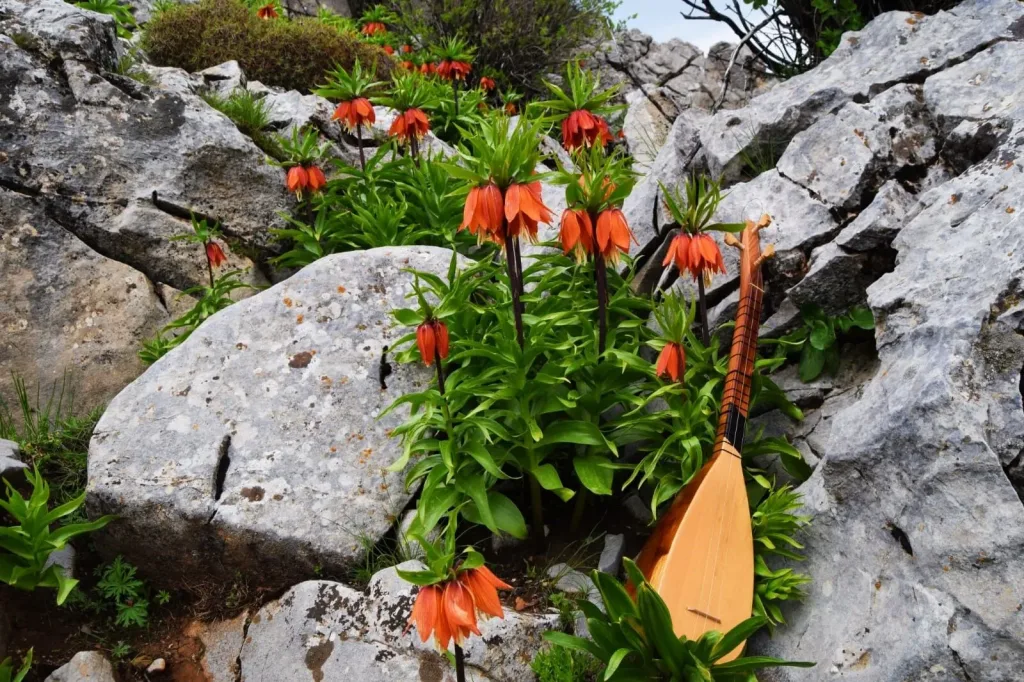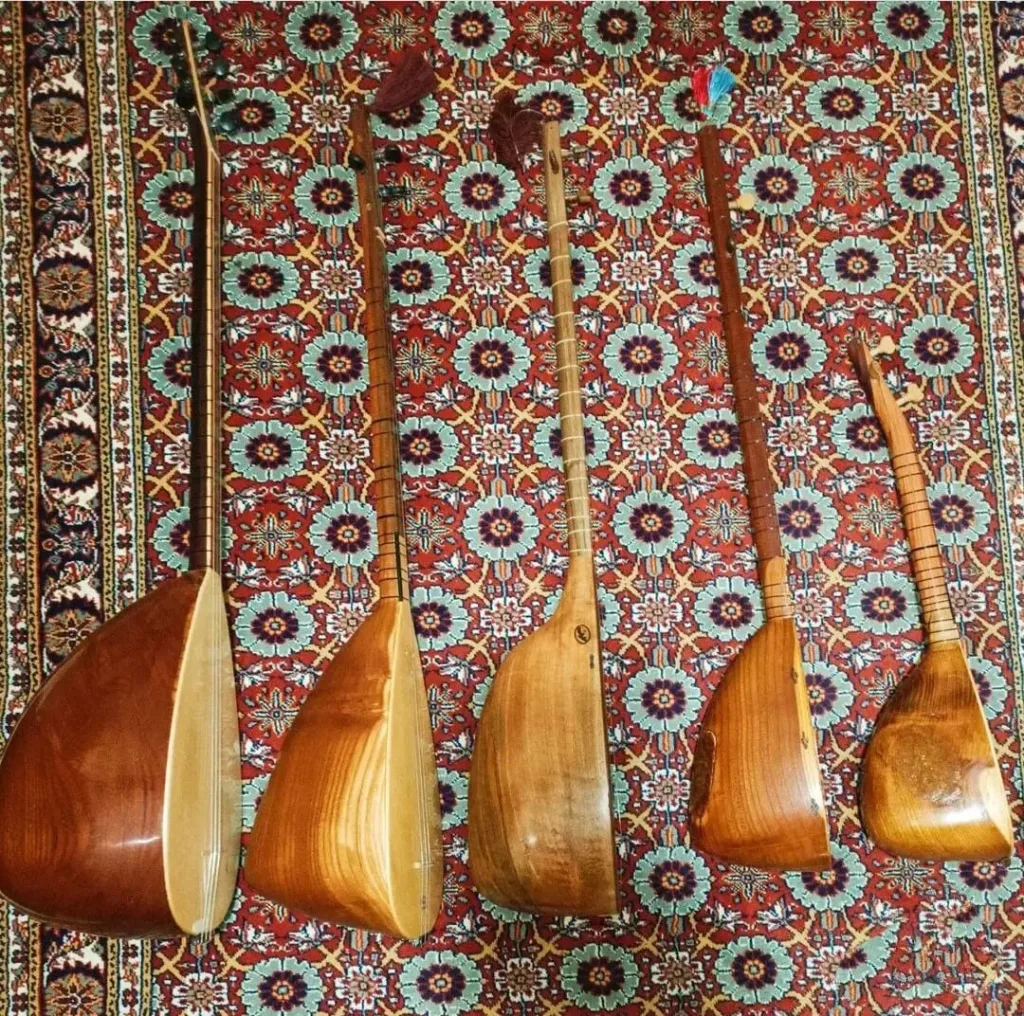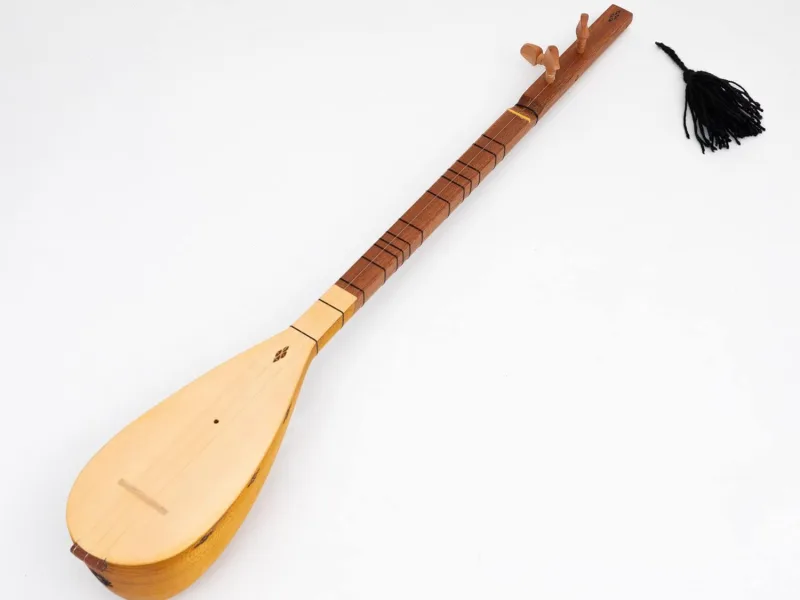The Bağlama is a popular stringed musical instrument in Turkic countries such as Turkey and Azerbaijan. In Anatolia, it is considered a folk instrument. It has strings, a long neck, and a rounded body. Depending on its size and number of strings, it takes on different names, ranging from meydan sazı to ırızva. It is played with a type of plectrum called a tezene, traditionally made from cherry tree bark. Instruments similar to the modern bağlama have been found in archaeological excavations of Sumerian and Hittite mounds in Anatolia, as well as in artifacts from the Archaic period and Ancient Greek works. The bağlama is a synthesis of historical musical instruments from Central Asia and the pre-Turkish Anatolian period. The word bağlama literally means “something that is tied,” likely referring to the instrument’s tied frets.
In the bağlama family, the instruments are referred to as Bağlama, Divan Sazı, Bozuk, Çöğür, Kopuz, Irızva, Cura, and Tambura. Among these, the smallest is the Cura, and the largest is the Divan Sazı. Today, we will introduce Irızva, one of the smallest members of the bağlama family.
Anatolian Turkmen culture has taken shape as a deeply rooted structure resulting from thousands of years of accumulation. This culture encompasses elements from belief systems to clothing, from social order to musical performance. Among the most important elements of this deep-rooted Anatolian-Turkmen culture is undoubtedly music. Within the traditional structure that has come down to us from Dede Korkut, many minstrels, mystical lovers, and performers have conveyed this legacy. Under the umbrella of Turkish folk music, many instruments today still preserve their traditional characteristics. One of the most important of these instruments is the Irızva, also known as Ruzba. Though nearly forgotten today and with very few remaining performers, we aim to introduce and pass on the knowledge of this instrument.

Irızva-Ruzba Instrument
The Irızva is a stringed instrument of Central Asian origin and is considered one of the most authentic instruments of the Turks. It consists of two strings and has its own unique tuning system and fret arrangement. Its performance differs significantly from instruments in the bağlama family. Originating from the kopuz family, the Irızva powerfully reflects traditional tones inherited from its roots. In recent years, the instrument has gained recognition, especially through performances by Nesimi Çimen. In Anatolian Alevi-Turkmen villages, zakirs (religious singers) play this instrument in a system known as the “Şıh düzeni“ (Sheikh tuning). The earliest known mention of the Irızva instrument in historical sources appears in the poems of Kaygusuz Abdal. Regarding the Irızva, Melih Duygulu states:
“Irızva: A stringed instrument similar to the bağlama. Mostly used in Southeastern and some parts of Eastern Anatolia, this type of instrument is nearly extinct today. Though it has variations such as ‘ravza’, ‘rızva’, and ‘ruzba’ (as in Evliya Çelebi’s Seyahatname), the most common form is ‘ruzba’. Among the Turkmens, due to local dialectal features, the word is pronounced ‘Irızva’ since the initial ‘r’ is dropped. The instrument may have two, three, or four strings in two-string groups or three to six strings in three-string groups. Among the Türkmen tribes in Çukurova, the Irızva is also called ‘karadüzen’. Although in some regions (such as Çukurova) it is played with a plectrum, it is mostly played with the fingers (şelpe technique). In the wide corridor between Muş and Adana, it is believed that the old name for instruments like the ‘dede sazı’ or ‘balta sazı’ used by Alevis was ‘ruzba/ırızva’. This remains a topic of further research.“
The Place and Importance of the Irızva in Anatolian Turkmen Culture
The Irızva is more than an instrument; it represents the embodiment of a cultural accumulation, faith, and customs transferred from thousands of years onto the mulberry wood and its strings. As the poet says, “two strings and a piece of wood, bowed to neither throne nor crown.” This reflects the essence of the Anatolian spirit. Similarly, Mustafa Kemal Atatürk once remarked: “Gentlemen, the culture of a nation finds its voice in this very instrument,” emphasizing its importance. Kaygusuz Abdal’s verse “Thirty kopuz, forty çeşte, fifty ıklık and rebab… Let the ‘two-stringed instrument’ be played in the room” has not been forgotten for 600 years. The kopuz and its descendants have been cornerstones in passing Turkish culture into the future. Through the Irızva, Anatolian people have expressed both their beliefs and daily struggles for centuries. In Turkish lands, where oral culture has historically outweighed written culture, this instrument has played a critical role in the transmission and archiving of oral traditions.

Structural Features of the Irızva
The Irızva is known as the smallest instrument within the bağlama or kopuz family. Its body is typically carved from mulberry wood. The neck or soundboard may be made from juniper or walnut. In Eastern Anatolia, the “balta tekne“ (axe-shaped body) style is more preferred. In regions like Malatya, Maraş, and Elazığ–Baskil, Irızvas have neck lengths of approximately 55–60 cm and body lengths of about 30 cm. The sound holes are created on the soundboard using various motifs. The fret system generally includes 12 or 13 frets. According to Alevi belief, the 12 frets represent the 12 Imams, a belief expressed by dedeler (Alevi religious leaders) and zakirs.
Materials Used:
- Body (Tekne): Mulberry or oleaster wood
- Neck (Sap): Juniper or hornbeam
- Soundboard (Göğüs): White pine or juniper
- Tuning Pegs (Burgu): Juniper wood
Tuning System of the Irızva
The tuning system of the Irızva consists of a lower and an upper string. Typically, the lower string is tuned to La (A) and the upper to Mi (E). In some cases, to enhance the sound, the lower string may be doubled—this does not make it a three-string instrument; the second lower string is only added to reinforce the tone. Sometimes, the lower string is tuned to Re (D) instead.
Irızva Playing Techniques
The Irızva is not played with a pick or plectrum. Instead, techniques such as pençe (finger strike) and şelpe (finger tapping) are used. In addition to these, string pulling and finger-picking techniques are also employed in performance.
Regions Where the Irızva Is Commonly Played
The Irızva has been performed across many regions of Anatolia. Its usage is more prominent from the Taurus Mountains to Eastern Anatolia. Its distinct style and technique are especially evident in Malatya Arguvan and Kahramanmaraş Elbistan. In Elbistan, it is more intensively played by members of the Sinemilli Alevi Ocak. In Elazığ’s Baskil district, particularly in Şeyh Hasan and Sün villages, a two-stringed version of the cura known as Irızva is played.

